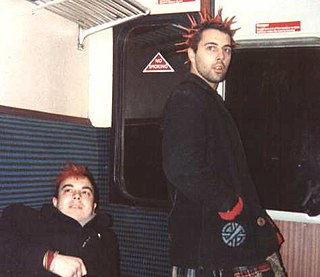
Punk fashion is the clothing, hairstyles, cosmetics, jewellery, and body modifications of the punk counterculture. Punk fashion varies widely, ranging from Vivienne Westwood designs to styles modeled on bands like The Exploited to the dressed-down look of North American hardcore. The distinct social dress of other subcultures and art movements, including glam rock, skinheads, greasers, and mods have influenced punk fashion. Punk fashion has likewise influenced the styles of these groups, as well as those of popular culture. Many punks use clothing as a way of making a statement.

To improve motorcycle safety, many countries mandate the wearing of personal protective equipment such as protective clothing and helmets. Protective clothing may include certain types of jackets, gloves, boots, and pants. Jackets meant for motorcyclists are typically made of leather or specialized man-made fabrics like cordura or Kevlar. These jackets typically include padding on the elbow, spine, and shoulder regions. This was once quite bulky, but modern technology and materials have made it unobtrusive. Gloves are generally made of leather or Kevlar and some include carbon fiber knuckle protection. Boots, especially those for sport riding, include reinforcement and plastic caps on the ankle and toe areas. Pants are usually leather, cordura, or Kevlar. Except for helmets, none of these items are required by law in any state in the USA, or in any part of the UK but are recommended by many of those who ride.

Rockers are members of a biker subculture that originated in the United Kingdom during the 1950s. It was mainly centred on motorcycles and rock 'n' roll music. By 1965, the term greaser had also been introduced to Great Britain and, since then, the terms greaser and rocker have become synonymous within the British Isles, although used differently in North America and elsewhere. Rockers were also derisively known as Coffee Bar Cowboys. Their Japanese counterpart was called the Kaminari-Zoku.
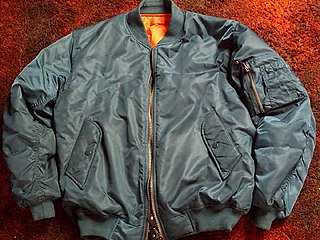
A flight jacket is a casual jacket that was originally created for pilots and eventually became part of popular culture and apparel. It has evolved into various styles and silhouettes, including the "letterman" jacket and the fashionable "bomber" jacket that is known today.

A café racer is a genre of sport motorcycles that originated among British motorcycle enthusiasts of the early 1960s in London. Café racers were standard production bikes that were modified by their owners and optimized for speed and handling for quick rides over short distances. Café racers have since become popular around the world, and some manufacturers produce factory-made models that are available in the showrooms.

Motorcycle safety is the study of the risks and dangers of motorcycling, and the approaches to mitigate that risk, focusing on motorcycle design, road design and traffic rules, rider training, and the cultural attitudes of motorcyclists and other road users.

Fashion of the 1980s was characterized by a rejection of 1970s fashion. Punk fashion began as a reaction against both the hippie movement of the past decades and the materialist values of the current decade. The first half of the decade was relatively tame in comparison to the second half, which was when apparel became very bright and vivid in appearance.

A cut-off, battle jacket, battle vest or kutte in heavy metal subcultures, is a type of vest or jacket which originated in the U.S. military, specifically the Army Air Corps, where pilots and other aviation personnel would collect patches or other insignia to put on regulation bomber jackets or flight suits. The practice continued within the biker subculture and auto racing subculture and later found popularity in punk and various heavy metal subcultures. Biker, auto racing, metal and punk subcultures differ in how the garment is prepared, what decorations are applied, and how this is done.
Aerostich, formerly Aero Design & Mfg. Co. Inc., is a company based in Duluth, Minnesota that produces and sells motorcycle safety clothing and other motorcycle related equipment, such as GPS systems, luggage, and hand tools. It was founded in 1983 by Andy Goldfine, who is also the founder of the nonprofit Ride To Work, Inc. and was elected to a third three-year term as an American Motorcyclist Association board member in 2008.
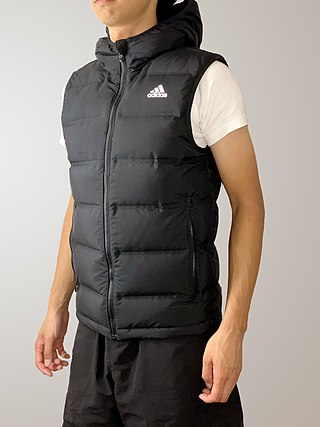
A gilet or body warmer is a sleeveless jacket resembling a waistcoat or blouse. It may be waist- to knee-length and is typically straight-sided rather than fitted; however, historically, gilets were fitted and embroidered. In 19th-century dressmaking a gilet was a dress bodice shaped like a man's waistcoat.

Schott NYC is an American clothing manufacturing company located in New York City. The company was founded in 1913 by brothers Irving and Jack Schott. Schott NYC was the first company to put a zipper on a jacket and they created the classic Perfecto motorcycle jacket, which was made popular by films such as The Wild One (1953). The company made clothing for the United States Armed Forces during World War II and later also for American law enforcement. Schott NYC is still owned by the Schott family and still manufacture much of their clothing in the United States.

Perfecto is a secondary brand of "lancer fronted" leather motorcycle jackets designed by Irving Schott and manufactured by the American clothing company, Schott NYC. The first jacket was introduced in 1928, making it the first such styled leather motorcycle jacket. There is some debate as to whether Marlon Brando wore a Schott Perfecto or a replica made by Durable in the 1953 seminal movie The Wild One. Punk rock pioneers The Ramones wore Perfecto jackets in the 1970s and fashion designers such as Jean Paul Gaultier created their variations in the 1980s.
Alpinestars is an Italian motorsports and action sports safety equipment manufacturer based in Asolo, Italy. Its lines include specialized products for MotoGP, motocross, motorcycling, Formula One, World Rally Championship, WEC, V8 Supercars, NASCAR, mountain biking, and surfing, and motorsports-themed, non-sports clothing, with fashion design centers in Italy and California offering products for men, women and kids.

Derek Minter was an English Grand Prix motorcycle and short-circuit road racer. Born in Ickham, Kent, with education starting in nearby Littlebourne, he was versatile rider who rode a variety of machinery between 1955 and 1967 at increasing levels of expertise and in varying capacities and classes.
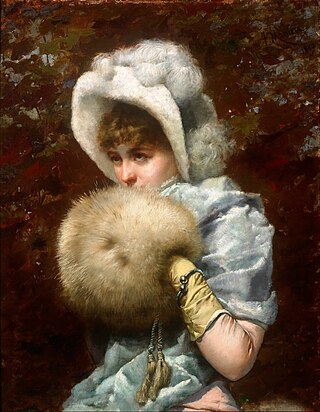
A muff is a fashion accessory for outdoors usually made of a cylinder of fur or fabric with both ends open for keeping the hands warm. It was introduced to women's fashion in the 16th century and was popular with both men and women in the 17th and 18th centuries. By the early 19th century, muffs were used in Europe only by women. It is also reported that the fashion largely fell out of style in the 19th century.

A leather jacket is a jacket-length coat that is usually worn on top of other apparel or item of clothing, and made from the tanned hide of various animal skins. The leather material is typically dyed black, or various shades of brown, but a wide range of colors is possible. Leather jackets can be designed for many purposes, and specific styles have been associated with subcultures such as greasers, motorcyclists, and bikers, mobsters, military aviators and music subcultures, who have worn the garment for protective or fashionable reasons, and occasionally to create a potentially intimidating appearance.

Colors are the insignia, or "patches", worn by motorcycle club members on cut-off vests to identify membership of their club and territorial location. Club patches have been worn by many different groups since the 1960s. They are regarded by many to symbolize an elite amongst motorcyclists and the style has been widely copied by other subcultures and commercialized.

Colin Jordan Seeley was a British motorcycle retailer who later became a motorcycle sidecar racer, motorcycle designer, constructor and retailer of accessories. In 1992 he was involved in running the Norton Rotary race team.

A car coat is an outer garment originally made to be worn by automobile drivers and passengers. First designed to provide maximum warmth and coverage, over time it became a much shorter garment. Today it describes a coat that typically ends at mid thigh. It is worn by both men and women.
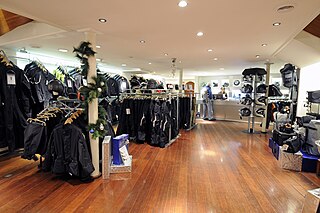
Motorcycle riding gear, or kit , is specialized clothing and equipment worn by motorcyclists. It usually serves multiple purpose at once, including crash injury protection, deflecting sun, precipitation or debris, keeping the rider warm, cool or hydrated, increasing visibility, expressing the rider's style or social identity, stowing cargo, and as a platform for wearable or embedded devices like wireless intercoms, GPS navigation devices, cell phones, or helmet-mounted displays.


























